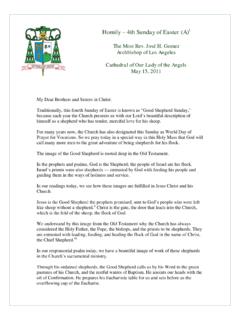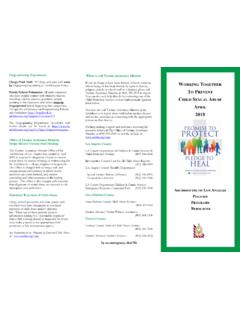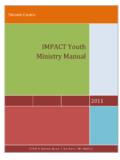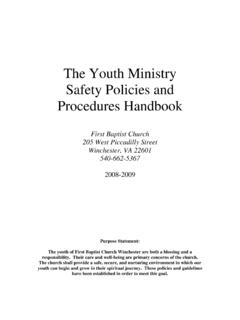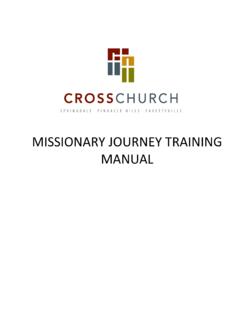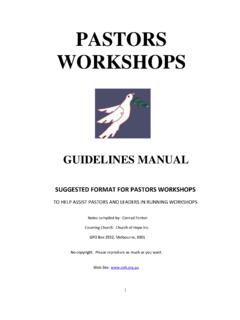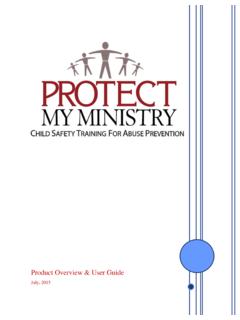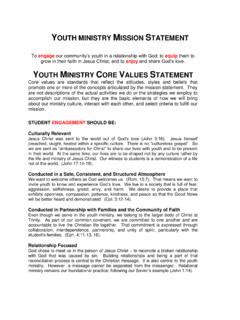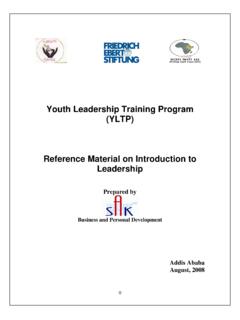Transcription of GUIDELINES FOR MINISTRY TO & WITH YOUNG …
1 GUIDELINES FOR MINISTRY TO & with YOUNG PEOPLE MINISTRY to and with YOUNG people in the Archdiocese of Los Angeles is firmly based on the United States Catholic Conference of Bishop s document Renewing the Vision: A Framework for Catholic youth MINISTRY which was published in 1997. It is the understanding in this Archdiocese that youth MINISTRY includes all ministries to and with YOUNG people. The GUIDELINES below entail three areas of MINISTRY : youth MINISTRY with YOUNG Adolescents (Jr. High), youth MINISTRY with Older Adolescents (High School), and the Confirmation Preparation Process. GUIDELINES FOR youth MINISTRY with YOUNG ADOLESCENTS (JR.)
2 HIGH) PHILOSOPHY Significant physical and emotional changes characterize the period of pre-adolescence and adolescence. While home and family remain the more powerful forces in the development of pre-adolescents and adolescents, their peer groups begin to exercise increasing influence on attitudes, values, and behavior. They learn to live the Christian faith by observing the good example of others whom they admire and trust. (National Directory for Catechesis, 48 D) Adolescence is one of the most fascinating and frustrating transitions in the life span, during which the accelerated rate of change and growth is second only to infancy.
3 It is a time of expanding horizons, self discovery, and emerging independence. In YOUNG adolescence the transformation from childhood to adulthood begins with the onset of biological, physical, behavioral, and social transformation. The spiritual development of YOUNG adolescents occurs not separate from, but as part of this transformational process. YOUNG adolescence is a critical point in life s trajectory. This period provides an optimal time for intervention to prevent destructive life patterns, and promote continuing healthy habits. Whether or not a YOUNG adolescent emerges into adulthood as a healthy, self-reliant individual will depend on the opportunities they have to develop positive attitudes and life skills during these formative years.
4 The objective of MINISTRY to and with YOUNG adolescents is to promote the full participation of these YOUNG people into the Christian community. This MINISTRY will work to provide these YOUNG adolescents with the opportunity to grow in knowledge of themselves, to share openly with their peers and to experience God personally and in community. GOALS Three interdependent and equally important goals guide the Church s MINISTRY with YOUNG people. These goals state what it means for the Catholic community to respond to the needs of YOUNG people and to involve YOUNG people in sharing their unique gifts with the larger community.
5 They express the Church s focus for MINISTRY with all adolescents, while encouraging local creativity in developing the programs, activities, and strategies to reach these goals (Renewing the Vision, 9). These goals will be the fundamental foundation for all ministries to YOUNG people. 1. To empower YOUNG people to live as disciples of Jesus Christ in our world today. 2. To draw YOUNG people to responsible participation in the life, mission, and work of the Catholic faith community. 3. To foster the total personal and spiritual growth of each YOUNG person. PROCESS The specifics of each MINISTRY to YOUNG adolescents will, obviously, vary from parish to parish.
6 However, there are four characteristics that seem to be present in most effective programs. 1. Personal Relationships Caring adult leaders, teachers/catechists, coaches, and chaperones work to build personal relationships with the youth they serve. Through them, YOUNG adolescents know that they are loved by God and feel at home in the Church. 2. Parental Support Parental support and ownership of the program is obtained through regular communication, parent education sessions, and numerous opportunities for parents to volunteer. Remember, most parents get involved in small ways such as assisting with publicity, transportation, or food preparation.
7 3. Input of YOUNG Adolescents YOUNG adolescents provide input into the planning of all programs/events and assist the adult leaders with specific tasks during each event or gathering. 4. Planning Team An organized planning team has designed a comprehensive program which responds to the diversity of needs of YOUNG adolescents. MINISTRY to and with YOUNG adolescents includes a variety of components, using several different formats. The program is evaluated at regular intervals throughout the year. 5. Include all Components of Comprehensive youth MINISTRY MINISTRY with adolescents utilizes each of the Church s ministries advocacy, catechesis, community life, evangelization, justice and service, leadership development, pastoral care, prayer and worship in an integrated approach to achieve the three goals for MINISTRY .
8 These components provide a framework for the Catholic community to respond to the needs of YOUNG people and to involve YOUNG people in sharing their unique gifts with the larger community. They provide a structure for the Church s MINISTRY with adolescents, while encouraging local creativity in developing programs, activities, and strategies for each component. The Catholic Bishops remind us, We have learned that no one strategy, activity, or program is adequate to the task of promoting the three goals for MINISTRY with adolescents and that families, parishes, and schools cannot work in isolation if the Church is to realize its goals (Renewing the Vision, 19).
9 This comprehensive approach is a framework for integration rather than a specific model. Each MINISTRY component supports and enhances the others. A comprehensive MINISTRY with adolescents provides balance among all eight components. This balance is achieved throughout a year or a season of programming. Even a single program or strategy can incorporate several of the MINISTRY components, as in the case of a retreat program. It usually takes a parish 2-3 years to incorporate most of the components in a comprehensive MINISTRY . Advocacy - interpreting the needs of youth and their families, especially the social problems facing them and acting with or on behalf of youth and their families for change in the systems which create or contribute to the social problems; giving YOUNG people a voice and empowering them to address the social problems that they face.
10 Catechesis - promoting a YOUNG person's growth in Christian faith as a living reality through the kind of teaching and learning that emphasizes understanding, reflection, and transformation; fostering in youth a communal identity as Catholic Christians within the intergenerational community of faith and helping them to develop their own personal faith identity. This is accomplished through systematic, planned and intentional programming (curriculum). Community Life - creating an environment which nurtures meaningful relationships characterized by Gospel values among youth and between youth and adults; helping YOUNG people feel like a valued part of the church; providing opportunities for social interaction and meaningful participation in the church and civic community.




